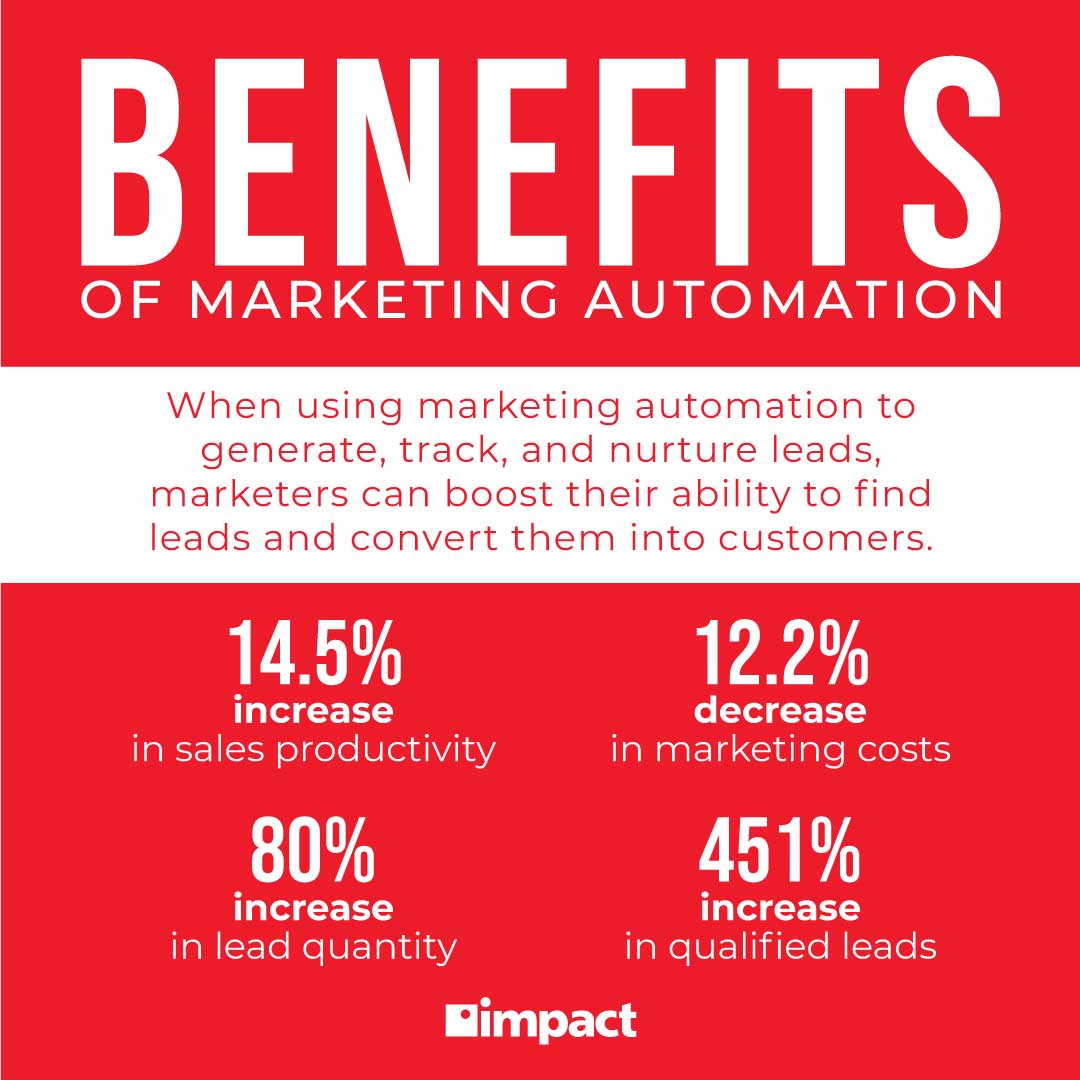Marketers must juggle a lot of things during the buyer’s journey. From initial touches to lead scoring, nurturing, and eventual conversion. These processes are not only time-consuming when done manually, but they’re not efficient or optimized to get the most out of your marketing efforts.
Lead tracking automation opens many doors for marketers to automate key processes, improve upon them, and free up their own time to focus on more productive tasks. Read on to explore more about how automation can improve the way you generate, track, and nurture leads.
How can automation help with lead generation, engagement, reporting, SEO, and more areas of marketing? Check out Impact’s blog What is Marketing Automation?, to learn more.
Benefits of Lead Automation and Tracking
Managing a lead through a marketing funnel gently, but intentionally, is important in increasing the chances they become customers. You can’t let your brand slip out of their mind, but you can’t overload them with content and emails without risking them becoming frustrated and unsubscribing.
So, how can marketers strike this delicate balance between being annoying and staying top of mind without spending every waking hour monitoring and tracking a lead’s actions? The answer is: automation!
With marketing automation for lead tracking, you can take lead management and implement automation and alerts to perfect email campaigns, send the right content, and track their progress as they move down the funnel.
There are numerous benefits to implementing marketing automation for lead tracking, but here are a few of the key areas that are positively impacted:
- More Accurate Reporting: Only the most numerically gifted of us enjoy putting together reports. It’s time-consuming, difficult, and monotonous. Instead, imagine getting an email every day with all the most important numbers gathered in a digestible way, literally delivered to your front door like the morning paper.
Not only is this easier, but it completely removes the risk of human error skewing numbers. It also provides more accurate reports, more often, with less time dedicated to them. - Marketing and Sales Alignment: With marketing and sales teams using the same automation platform, it becomes significantly easier to align goals and efforts. Also, it drastically increases the effectiveness of both teams. When using automation software, companies saw a 451% increase in qualified leads.
- Higher Conversion Rates: With automated nurturing campaigns, businesses can send more personalized marketing materials to prospects (49% of businesses said automation made this possible). This means not only increasing the number of leads generated and qualified but also converting more of them into customers to grow your business. 75% of businesses that implement marketing automation solutions saw a meaningful increase in conversion rates.
- More Effective Marketing Teams: One of the hallmarks of automation in modern business is clearing the way for your teams to focus on tasks that require more creativity. Whether it’s ideas for new content, campaigns, ads, or user experiences, you can remove the need to spend so much time on tasks like lead management, campaign management, or data input with automation. 49% of businesses said that introducing more automation into their marketing efforts saved time they could direct toward more meaningful projects.
How Automation Helps with Lead Tracking
1. Track Every Detail of Your Lead’s Timeline
Track every detail about a lead’s journey—every touchpoint, email, page visit, download, social media interaction, and more—all in one place. Automated tracking brings together all the information you need on prospects and leads. This makes it easier to understand a lead’s habits, define a clear path toward conversion, and see if your current marketing efforts are working and engaging.
Is your lead interacting with content? Reading it all? Even opening your emails? Automated lead tracking gives you every insight into a lead’s progression, up-to-date and in one place.
2. Automated Lead Scoring
Lead scoring can also be automated so your team doesn’t have to spend time collecting data to calculate points individually and manually for each lead—something that can take hours on end. Instead, your unique scoring system can be implemented into an automation system.
This removes the need for your marketing team to spend time qualifying leads and improves the accuracy of the process by mitigating the risks of human error.
3. Segment and Manage Your Database with Lead Automation
Make it easier for you and your team to build stronger campaigns by introducing automation into the segmentation process. This allows you to send more personalized materials to different types of people so that you’re able to share content that lines up closer to their interests. This improves open rates, engagement rates, and lead conversions by strengthening your campaigns.
80% of consumers report they are more likely to buy from businesses that personalize their marketing experiences
Previously, this process was manual—if done at all—meaning you risked sending the wrong information to the wrong people at the wrong time; increasing the risk of them unsubscribing, reporting you as spam, or just deleting your emails as quickly as possible.
4. Automatically Track and Perform Lead Nurturing
Lead nurturing is a time-consuming task. Marketers must juggle sending emails, sharing relevant content, and appropriately engaging with leads to ensure they’re getting relevant information and content during every step of the process in hopes of pushing them down the funnel.
Every customer has a unique journey and often none are the same, so tracking progress is key in determining if the current processes are working and identifying the right time to continue engaging.
Automation can take these tasks from your team, and perform them automatically based on collected data.
Additionally, this tracked data can help your marketing team make more data-driven decisions by providing insights on email open rates, the most effective sending times and days, and an overall look at how campaigns are faring with certain segments and people to help optimize future marketing efforts.
5. Sales and Marketing Cohesion
All of what we talked about above (better reporting, automated nurturing, activity tracking, segmentation, and lead scoring) can also be used by the sales team to help them hone their pitches and organize their strategies.
Marketing automation improves sales productivity by 14.5% and 27% of companies said it improved their sales and marketing collaboration.
With integrated marketing automation systems, all this data is accessible company-wide to anyone who can make use of it, creating more of a connection between marketing efforts and the sales team.
Other Forms of Marketing Automation
Other than lead tracking and management, marketing automation comes in many shapes and sizes to help marketers tackle a variety of tasks and remove roadblocks from multiple processes, including:
- Audience Management
- Customer Relationship Management (Customer Service)
- Email Marketing
- Social Media
- Content Management
- Digital Ads and Retargeting
- Analytics and Reporting
- Lead Generation
- SEO
In Conclusion
With automation, marketers can take lead management and tracking by the horns and make better use of technology to optimize campaigns and improve lead nurturing, lead management, and sales and marketing alignment.
But marketing automation services provide much more than just lead tracking, they can impact every area of marketing, helping teams optimize processes across the board, strengthening marketing efforts, and generating more leads. Learn more about all the types of marketing automation with Impact’s blog, What is Marketing Automation?

